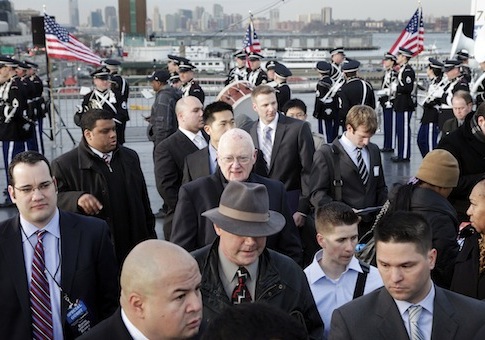Joseph Wagner and his unit in the Marines were being held against their will. Their captors?
The U.S. Marines.
They had just returned from Iraq and were preparing to exit the military and move back into the civilian world.
"We just got home from deployment. We all want to go out and drink a lot and see all our family, and do all the other celebratory things after getting home," Wagner said, recounting his final days in the service.
However, instead of enjoying their friends and family, the soldiers were sitting in a classroom, their minds absent, enduring PowerPoint presentations about the resources they had at their disposal for reintegrating into the outside world.
Wagner’s experience—"death by PowerPoint"—is all too common in the military, said Paul Rieckhoff, founder of Iraq and Afghanistan Veterans of America.
This inconvenient information overload itself may be small, but when combined with many other aspects of soldiers’ reintegration into society, it forms part of a vast array of factors that hinder returning soldiers’ search for a job in the civilian world.
So argued the panelists at "Employing America’s Veterans," an event Friday morning hosted by Real Clear Politics at the Newseum in Washington, D.C., to discuss the challenges veterans face in finding a job in the civilian workforce.
Experts from multiple non-profits, the Department of Veterans Affairs (VA), and the Marines all shared their insights and experiences from working with veterans transitioning into the workforce after leaving the military.
A large cultural chasm sits between the military and the civilian world, the panelists all testified. This gap can manifest itself in the language workers use to address their bosses to confusion about military jargon to misconceptions about the health and stability of veterans returning from combat zones.
This chasm has translated into higher unemployment for returning veterans. While the non-veteran population as a whole has an unemployment rate of 7.6 percent, veterans who served since September 2001 have an unemployment rate of 9.2 percent, according to the Bureau of Labor Statistics. (The unemployment rate for all veterans since World War II is 7.1 percent.)
Soldiers have tremendous "soft skills" like discipline, leadership, and teamwork that can be an asset to any corporation, said Kevin Schmiegel, executive director for the Chamber of Commerce Hiring our Heroes program.
Schmiegel himself served 20 years in the Marines before taking a job with the chamber, where he learned of the trouble returning veterans were having finding jobs. He started Hiring our Heroes, which runs hundreds of job fairs across the country for veterans in order to help veterans connect on the local level with employers.
"Public private partnership in local communities—that’s how you get this done," he argued.
Veterans often face the stigma from potential employers of being "damaged," Rieckhoff said. This characterization is sometimes true, he conceded—veterans sometimes return with physical or mental disabilities.
"But they are also arguably the most incredible group of leaders this country has at its disposal," Rieckhoff contended.
"They are an investment, not a charity," he argued.
He pointed to soldiers’ entrepreneurial spirit as an example of their potential value.
"If you’re on a remote checkpoint in Afghanistan and you’ve got limited resources, limited guidance, tremendous pressure, you’ve got to be decisive—you get entrepreneurial pretty damn quick," he said.
Systemic challenges still face veterans entering the civilian workforce despite their potential additions to companies, the panelists said.
Businesses typically hire individuals who have already been trained, while the military flips that process, hiring people and then training them for the job, said Curtis L. Coy, deputy under secretary for economic opportunity at the VA.
Coy said he is working to get businesses to use the resources from the VA, like grants to support apprenticeships for veterans.
Veterans often have trouble pitching their skills and experiences to potential employers, the panelists said. They can also be reluctant to talk about what they have done individually after being in such a team-oriented culture, said Brian Bilski, a major in the Marine Corps who works with transitioning wounded warriors.
Bilski also noted that the resources available to veterans are very fragmented. There are many groups and programs, but no centralized place where veterans or businesses looking to hire veterans can turn—a problem reflected in the "death by PowerPoint" information overload.
The years-long backlog for disability claims at the Department of Veterans Affairs contributes to the unemployment rate among veterans, the witnesses said. Trying to receive disability benefits can be exhausting and demoralizing, the panelists said.
Coy said that the VA is fully aware of the backlog and is taking measures to correct it, including working on the oldest claims first and mandating overtime.
These efforts, which are relatively well known, did not keep the other panelists from criticizing the VA. The strongest critique came from Rieckhoff, who called the backlog "inexcusable" and a "scandal."
"When you file a disability claim, you shouldn’t have to wait 5 years," he said.
